Cycling in Tuscany: Salute! to winery hopping on two wheels
(Director’s note: I’m currently traveling in Central Asia and am running a couple of old armchair travel blogs. This one is from May 2016.)
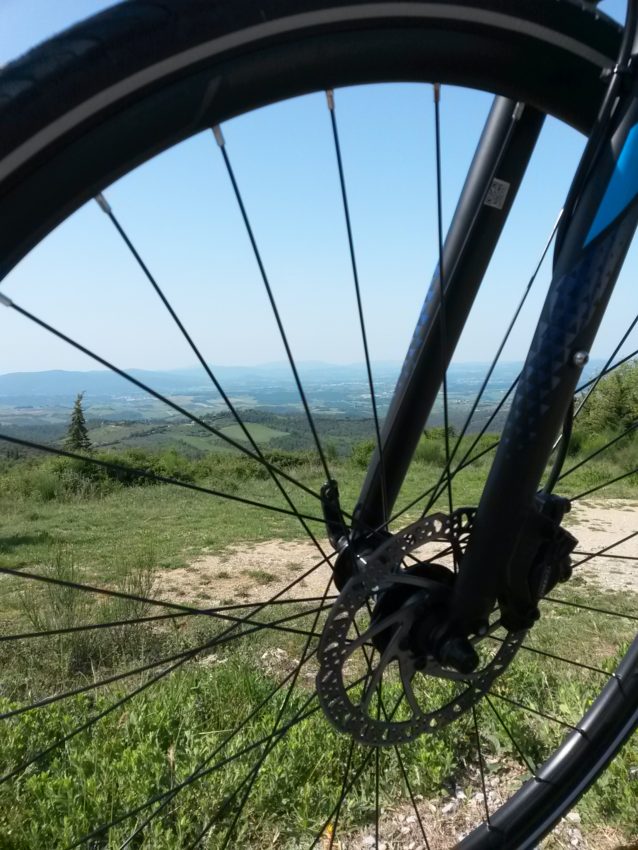
MONTERIGGIONI, Italy — I covered pro cycling for 10 years for The Denver Post and one question I asked pro cyclists when I first started was how much do they enjoy the scenery? Every cycling shot I see is of the cyclists cruising past fields filled with sunflowers or along an ocean beach or crisscrossing up a snowcapped mountain range. This is arguably the most beautiful sport in the world. Yet I usually got the same response.
“What scenery?”
Pro cyclists are too occupied jetting down mountains at 65 mph to gaze at green meadows. They’re too stressed trying to manage their final breakaway to ponder a sidewalk cafe in a French village.
We weekend hackers don’t have to worry about that. On my bike ride in Tuscany Tuesday, my biggest stress was which Chianti to buy.
Living in Rome is a cycler’s paradox. Rome is to cycling what Tehran is to nightclubs. It’s one of the least cycling friendly cities in the world. There are no bike paths. The cobblestones are brutal. The drivers are worse. I once wrote a blog about trying to cycle along the Tiber River to Ostia on the sea and wound up in a gypsy camp. Cycling in Phnom Penh is better. However, I’m only a short ride from some of the most beautiful cycling terrain in the world. It’s where grape vines flicker in the sun under emerald green hills. It’s where wildflowers of red, purple and orange line forest roads and lead to quaint villages where wine flows like water and the air smells of cheese and prosciutto.
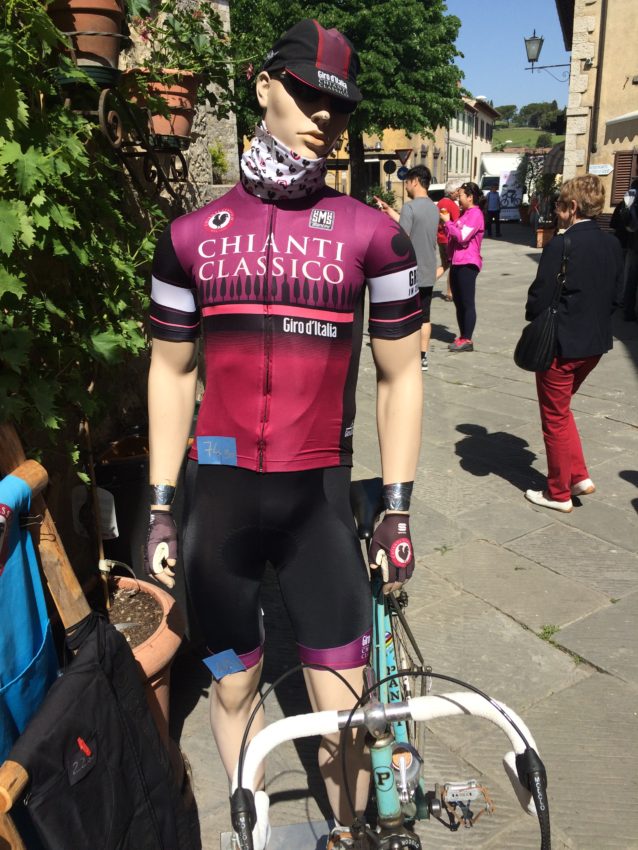
Cycling in Tuscany is such a remarkable experience it’s almost a cliche. But like all overused terms, the core is truth. On Tuesday I took my first Tuscany bike ride. In Tuscany, cycling takes on a different quality. Wineries dot Tuscany like snowflakes on a ski slope. You can’t ride more than 30 minutes without seeing neat rows of grapevines behind an 18th century house teasing you with outdoor tables and a view of a meadow.
I went with a company called Bike Florence & Tuscany (www.bikeinflorence.com, info@bikeinflorence.com). Piero Didona and his wife, Elena Boscherini, started the company three years ago after Piero ran a bike shop for 20 years. They both have those lean, tanned bodies that are the committed cyclist’s calling cards. This isn’t just a business to them. Cycling is their passion. Piero told me when he’s not leading tours, he’s riding, sometimes up to 100 miles in a day. Riding in Tuscany always appealed to me. But one thought haunted me as I took the dawn train ride 90 minutes from Rome to Florence.
I haven’t even sat on a bike in three years.
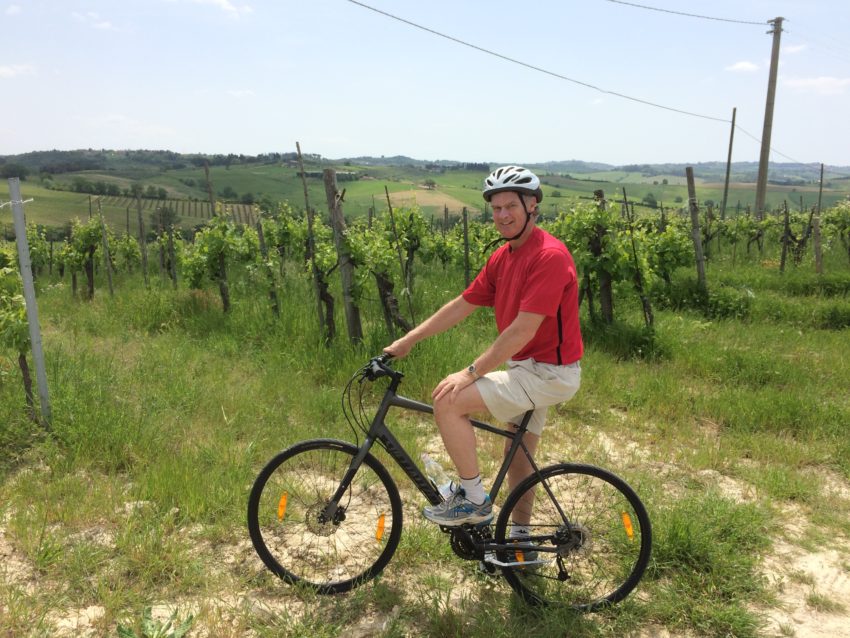
I wrote about cycling but I’m not a cyclist. I always thought cycling is how you go to a 7-Eleven when your car breaks down. Part of my problem stems from riding the same bike I received as my high school graduation present in 1974: a 10-speed Raleigh Grand Prix that weighed just slightly less than my Honda Accord. The bike lock alone could shackle most minimum-security prisons.
Piero told me not to worry. It isn’t difficult. He did offer a pseudo warning.
“You have to be fit,” he said. “Tuscany isn’t flat. Some people think they’re fit because they bike 150 miles per week but they’re riding in Florida. It’s very flat. After the first hill they about die: ‘We don’t have this at home.’”
I wasn’t concerned. After all, if we’re cycling to Tuscan wineries, I’ll find that extra gear.
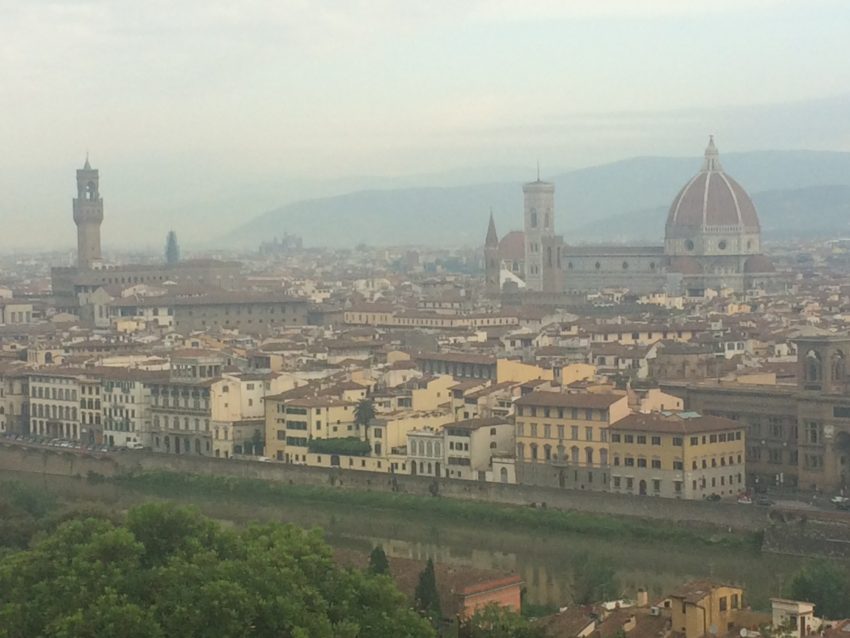
Elena met me at the train station and immediately took me to a spot in Florence I’ve never seen. Piazzale Michelangelo offers a spectacular view of one of the world’s prettiest cities. Florence’s famed brick-domed Duomo stood out through the morning haze over a quilt of red-tiled roofs.To the left was the tower of Palazzo di Vecchio and running below was the Arno River, looking as fresh as a mountain brook in Colorado compared to the filthy Tiber. Florence is so overrun with tourists all year it’s hard to find a quiet spot in the city.
This is one of them.
A young couple from New York met us and we drove up the winding hills to the town of San Donato where we met Piero and a family of five from Chicago. This is where we would start our adventure. As it turns out, I had nothing to worry about. The trip is basically a wine tasting with cycling thrown in. We covered only 13 miles, mostly downhill. We started at 1,800 feet and ended at 600. You do the math.
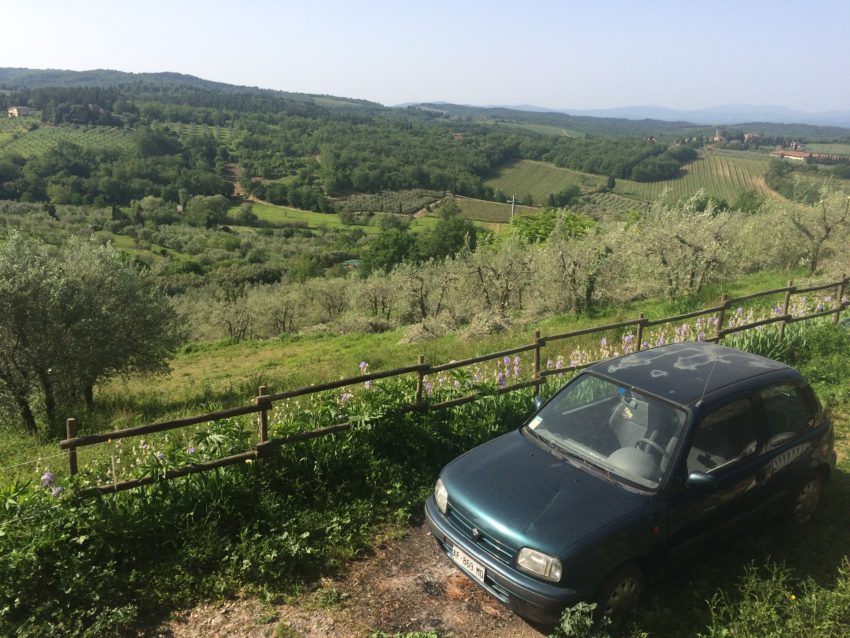
I didn’t feel bad dressed like I, indeed, was going to the 7-Eleven because my car broke down: baggy beach shorts, red T-shirt and Nikes. Not one of us eight riders had a stitch of Lycra. If you’re into wine and need an excuse to ride a bike again, this is the trip to take.
The entire trip is done in the famed Chianti region which spreads like a wine stain over nearly half of Tuscany. One of the major things I took away from this trip — along with two terrific bottles of wine — is the difference in Chiantis. The Chianti region covers several overlapping areas designated as Denominazione di Origine Controllata (DOC) and Denominazione di Origine Controllata e Garantita (DOCG). To be labeled a Chianti, a wine must consist of at least 80 percent Sangiovese grapes. And the grapes must come from these regions to guarantee this important DOC or DOCG label on the bottle. If you buy a Chianti without one of those on the label, save it for cooking or your cat.

Chianti is the pride of Tuscany and one of the prides of Italy. And it is massively popular around the world. Every year this small region produces 8 million cases of wine. Not all are the same. Pay attention and impress your friends at your next dinner party:
Chianti: A simple Chianti is a blend or consists of some grapes found outside the designated regions.
Chianti Classico: The grapes come only from a Chianti sub-region in Chianti’s heartland. Only Chianti from this area can use the black rooster seal (the gallo nero) on the neck of the bottle.
Chianti Reserva: Is aged at least 38 months instead of the usual four to seven. At least one year must be stored in wood.
Chianti Gran Selezione: Made with the very best grapes from the same vineyard as a reserva and stored at least 18 months.

San Donato is a good place to start. At 1,800 feet, it felt cool despite the beaming sunshine. I strolled through the village which was about 100 meters long. I heard roosters crowing. I saw old men chat in front of a cafe. I looked down from the height over an array of purple wildflowers and saw vineyards and meadows and forests. All I needed was a glass of wine.
The bikes loaned to us were high-end Specialized, the American bike company that’s the top selling bike in Italy. Mine was a 27-gear hybrid that felt like a Maserati after 40 years on my Raleigh. We wheeled down the hill, going just slow enough to take in the incredible green panorama below us. With so few hills, it was like riding through Tuscany in a convertible and at the end of a 20-minute ride one of the best glasses of wine in the world waited for us, not to mention Simone, their assistant, handing out wet towelettes.
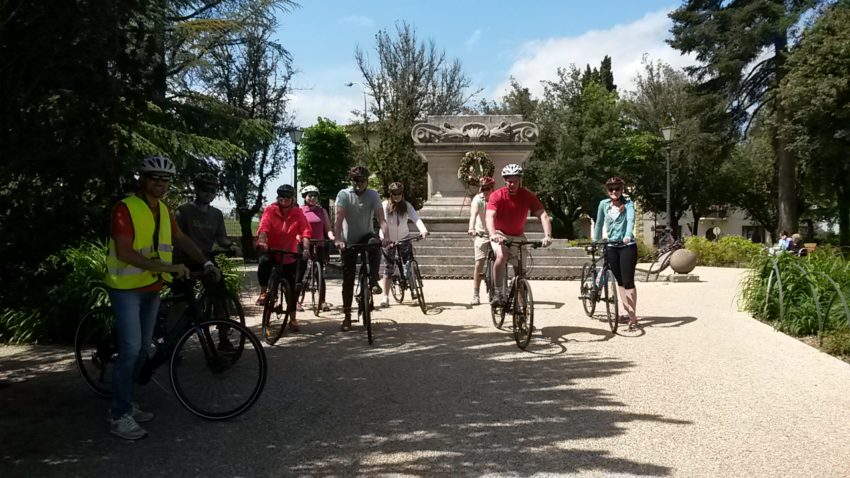
We came into the town of Castellina in Chianti. Its one main drag is lined with Italian specialty shops ranging from espresso makers to dried risotto to leather belts. A souvenir shop sold Lycra cycling jerseys labeled Chianti Classico in Chianti’s purple color in honor of the Giro d’Italia bike race that’s coming through town today. An underground street has a cozy enoteca and the back entrance to our first wine tasting. I looked at my watch. It was 11 a.m.
“You can’t drink all day if you don’t drink in the morning,” deadpanned one of the riders.

Aleandro opened Le Volte Enoteca in 1960 and is still running around the store in his wine apron to this day. The brick, arched store smelled of cheese and cinghiale, the wild boar that are as plentiful in Chianti as corkscrews. Le Volte is such a fine store, it serves a bottle of balsamic vinegar from Modena on a gold pillow in a wooden case for 145 euros.
Aleandro’s burly French assistant, Gilles Kehren, started us off with a Vernaccia, the famed white wine from San Gimignano, the Tuscan town known worldwide for its massive towers. It’s as good a white wine produced in Tuscany and one overlooked by those drowning themselves in Chiantis and Montepulcianos.
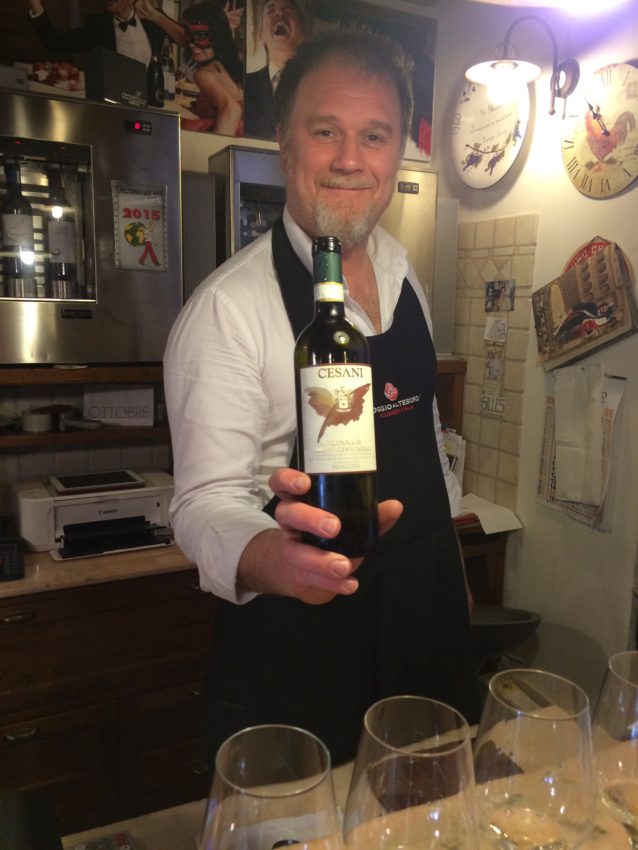
I fell for a wine I’d never heard of: the Bolgheri. The Bolgheri Superiore is a blend of Cabernet Sauvignon, Merlot and Cabernet Franc. It’s deep, rich and full bodied and well worth the 31.50 euro retail. Giles plied us with slivers of cinghiale and pork sausage on bread and we were ready to head back down the hill.
We wound down the hill over some lovely long stretches of flat road where each turn offered new villages in the distance to see. We could even see San Donato high above us but just below us around the next turn was our destination.

Lornano is a winery/agriturismo outside the town of Monteriggioni. An agriturismo is like a villa but in a farmhouse. I took one look after walking down the gravel path and immediately wanted a reservation for June. A sparkling turquoise swimming pool overlooked the rolling green Tuscan countryside. A small cast iron table and two chairs stood on a patio lined with vines, shrubs and white flowers. The stone buildings housing the rooms looked like something Leonardo Da Vinci may have stayed in while resting from painting Madonnas.
And inside the main quarters were barrels upon barrels of some of the best wine in the world.

Angioletta took us into the crispy cool storage areas where she explained the fermentation process. She showed us a glass designed by Michelangelo that takes the excess gas from the wine barrels. We had tastings of a whole array of Chiantis which became extraordinarily educational for someone like me who has made wine one of my four major food groups. Living in Rome, Chianti has become the table wine I get when I don’t want to spend money on something better.
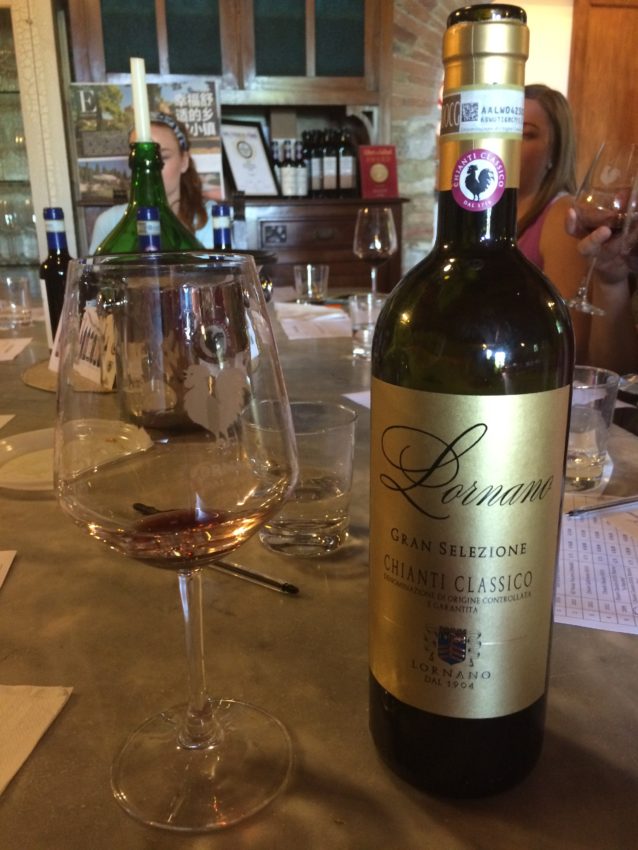
But in Tuscany, especially at Lornano, I re-fell in love with Chianti. The first Chianti Classico I had, a 2012, was 100 percent Sangiovese and absolutely terrific. Rich enough to serve with spicy Italian sausage but light enough to drink with crackers and cheese. It was an absolute steal at 19 euros.
I tried the Chianti Gran Selezione. Its classy gold label well represented its 62-euro price tag but I’m not discriminatory enough — or rich enough — to tell much of a difference. All I could think of was sipping that bottle of Chianti Classico in June, poolside with my girlfriend, Marina, looking down at rural Tuscany.
I had to wake from my daydreaming to get back on my bike for our last stretch. This one consisted of three little hills that wouldn’t rate a Category 5 on the Giro’s Cat 1-5 mountain chart (5 being the easiest) but did rate a warning from Piero that anyone not feeling up for it can ride in the chase car. One woman did. The rest plowed along. As I rested at the top of the rise after barely breathing hard — more from the ease of the three climbs on my two-wheeled Maserati than any fitness — two women were walking their bikes uphill.
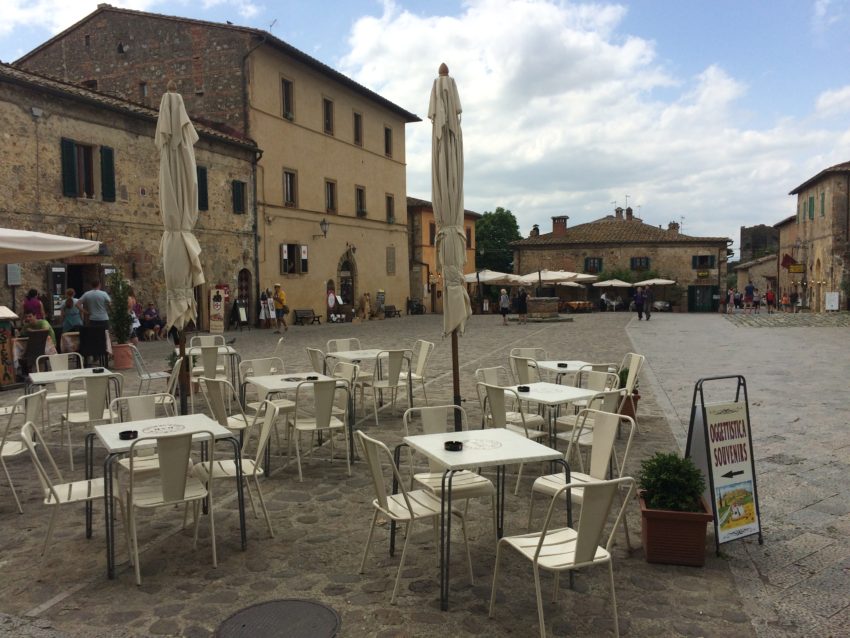
They managed to make it to the village of Monteriggioni, a medieval walled town founded in 1215 and mentioned in Dante’s “Divine Comedy.” It’s still populated by only 42 people. Its piazza, inside 1,870 feet of walls, houses a gargantuan Romanesque church and Antico Travaglio, a cute trattoria where we sat in an enclosed courtyard. Over a bowl of papperdelle cinghiale, one of the trademark dishes of Tuscany, I asked Piero about the massive popularity of cycling in Tuscany. It is as romantic as it sounds.

“Now cycling is becoming more popular,” he said. “More people are looking for beautiful places to express themselves. More tourists are bikers.” His company runs bike tours 12 months a year and have all levels of routes, including some similar to the Giro stages for the serious masochists.
We went upstairs to our last wine tasting. Monte Chiaro Terre della Grigia is in the first building in town, built nearly 1,000 years ago. Seila Bruschi is a wildly enthusiastic blonde sales manager who gave us the rundown. “See that church?” she said pointing to the one across the street before pointing around the store. “This is my church.”
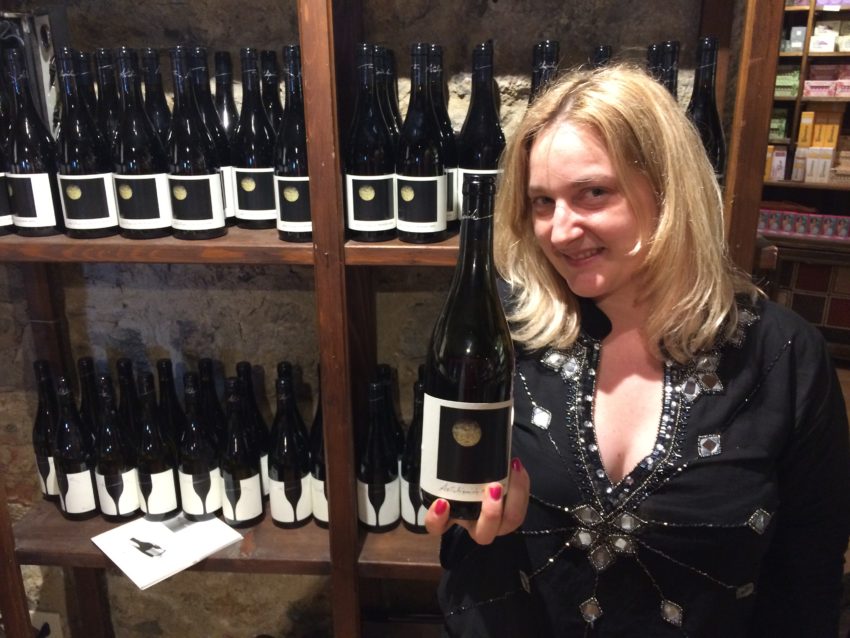
She had me try a Malvesia Nera. It’s 100 percent Pinot Noir, exactly the same as my native Oregon which boasts — and I agree — the best Pinot in the world. The Malvasia was damn close. Adding chunks of Chianti-induced pecorino, I knew what I’d have on my terrace the next time I got home.
Cycling in Tuscany. It was more fun exercise than a workout but the views were only surpassed by the wines. The biggest surprise wasn’t the ease of the cycling but the reasonable prices of the world-renowned wines. Next time I see a pro cyclist I know what I’m going to tell him.
You have no idea what you’ve been missing.


May 15, 2016 @ 3:30 am
My kind of cycling: downhill with wine!